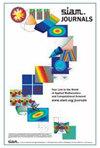Wavenumber-Explicit Parametric Holomorphy of Helmholtz Solutions in the Context of Uncertainty Quantification
IF 1.9
3区 工程技术
Q2 MATHEMATICS, INTERDISCIPLINARY APPLICATIONS
引用次数: 0
Abstract
A crucial role in the theory of uncertainty quantification (UQ) of PDEs is played by the regularity of the solution with respect to the stochastic parameters; indeed, a key property one seeks to establish is that the solution is holomorphic with respect to (the complex extensions of) the parameters. In the context of UQ for the high-frequency Helmholtz equation, a natural question is therefore: how does this parametric holomorphy depend on the wavenumber ? The recent paper [35] showed for a particular nontrapping variable-coefficient Helmholtz problem with affine dependence of the coefficients on the stochastic parameters that the solution operator can be analytically continued a distance into the complex plane. In this paper, we generalize the result in [35] about -explicit parametric holomorphy to a much wider class of Helmholtz problems with arbitrary (holomorphic) dependence on the stochastic parameters; we show that in all cases the region of parametric holomorphy decreases with and show how the rate of decrease with is dictated by whether the unperturbed Helmholtz problem is trapping or nontrapping. We then give examples of both trapping and nontrapping problems where these bounds on the rate of decrease with of the region of parametric holomorphy are sharp, with the trapping examples coming from the recent results of [31]. An immediate implication of these results is that the -dependent restrictions imposed on the randomness in the analysis of quasi-Monte Carlo methods in [35] arise from a genuine feature of the Helmholtz equation with large (and not, for example, a suboptimal bound).不确定量化条件下Helmholtz解的波数显式参数全纯性
在偏微分方程的不确定性量化理论中,解相对于随机参数的规律性起着至关重要的作用;事实上,人们试图建立的一个关键性质是,对于参数的(复扩展),解是全纯的。在高频亥姆霍兹方程的UQ的背景下,一个自然的问题是:这个参数全纯如何依赖于波数?最近的论文[35]表明,对于具有系数对随机参数仿射依赖的特定非捕获变系数Helmholtz问题,解算子可以解析地连续一段距离进入复平面。在本文中,我们将[35]中关于-显参数全纯的结果推广到更广泛的一类具有任意(全纯)依赖于随机参数的Helmholtz问题;我们证明了在所有情况下,参数全纯的区域都随着减小,并且证明了减小的速率如何取决于无摄动亥姆霍兹问题是捕获还是非捕获。然后,我们给出了捕获和非捕获问题的例子,在这些问题中,参数全纯区域的随减小率的界限是明显的,捕获的例子来自[31]的最新结果。这些结果的直接含义是,[35]中对准蒙特卡罗方法分析中的随机性施加的-相关限制来自具有大(而不是,例如,次优界)的亥姆霍兹方程的真实特征。
本文章由计算机程序翻译,如有差异,请以英文原文为准。
求助全文
约1分钟内获得全文
求助全文
来源期刊

Siam-Asa Journal on Uncertainty Quantification
Mathematics-Statistics and Probability
CiteScore
3.70
自引率
0.00%
发文量
51
期刊介绍:
SIAM/ASA Journal on Uncertainty Quantification (JUQ) publishes research articles presenting significant mathematical, statistical, algorithmic, and application advances in uncertainty quantification, defined as the interface of complex modeling of processes and data, especially characterizations of the uncertainties inherent in the use of such models. The journal also focuses on related fields such as sensitivity analysis, model validation, model calibration, data assimilation, and code verification. The journal also solicits papers describing new ideas that could lead to significant progress in methodology for uncertainty quantification as well as review articles on particular aspects. The journal is dedicated to nurturing synergistic interactions between the mathematical, statistical, computational, and applications communities involved in uncertainty quantification and related areas. JUQ is jointly offered by SIAM and the American Statistical Association.
 求助内容:
求助内容: 应助结果提醒方式:
应助结果提醒方式:


